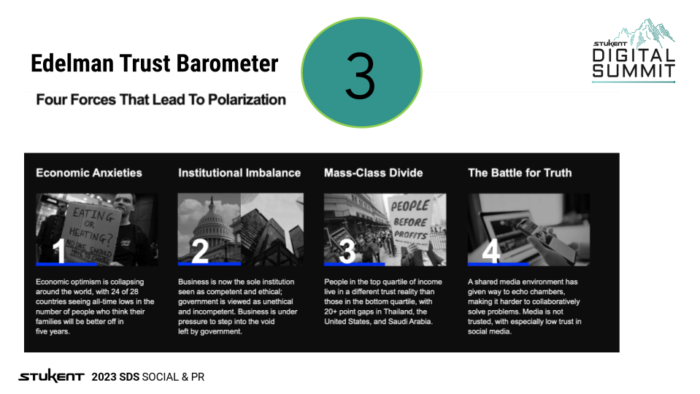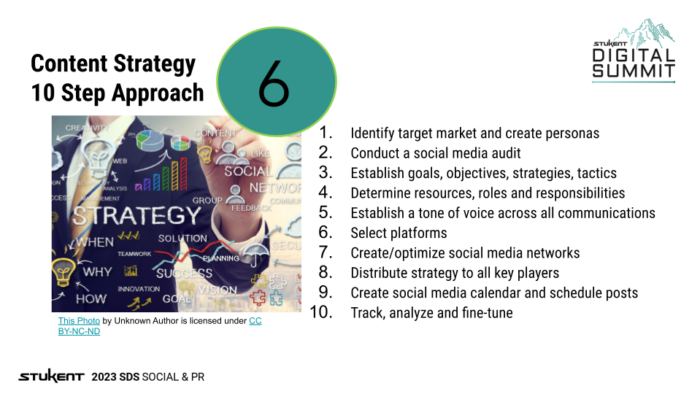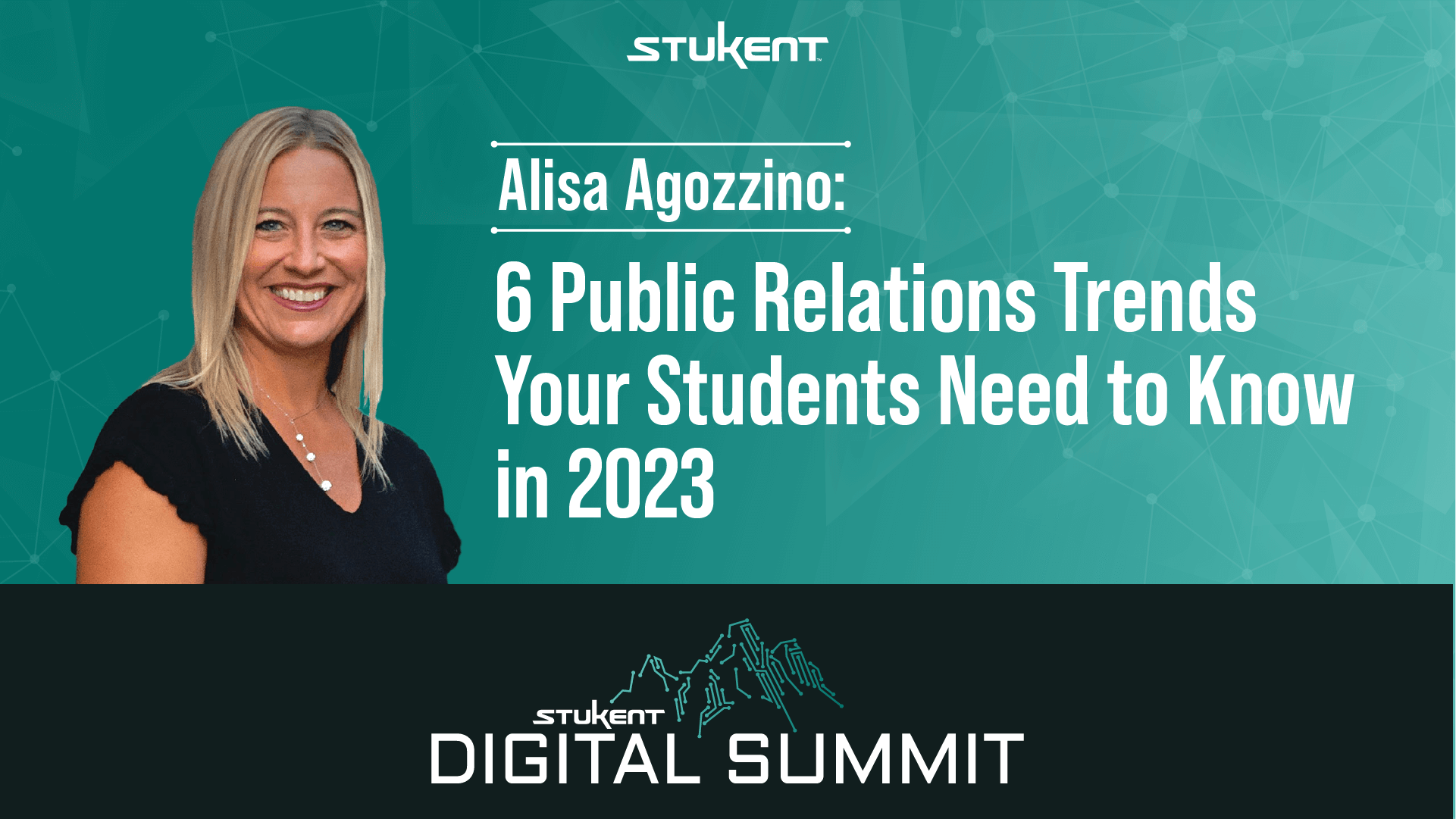Amidst the rise of AI, which has captivated headlines for months, several new tools and techniques have shaped the public relations world. With so much to learn, the Stukent® community gathered for the Stukent Digital Summit: Social & PR to gain insights on public relations, social media marketing, and integrated marketing communications instruction.
Alisa Agozzino, an associate professor of public relations at Ohio Northern University, shared the latest trends she has seen in her industry. If you couldn’t make the event, read on for the six public relations trends she shared in her session, “Besides July, what is HOT in Public Relations in 2023?”
1. Importance of Social Responsibility
One of the significant trends shaping the PR landscape is the growing emphasis on social responsibility for brands and businesses.
Consumers are increasingly aware of companies’ impact on society and the environment. They expect businesses to act ethically, sustainably, and with a genuine concern for social issues. Alisa believes PR professionals should be adept at crafting campaigns and messages that showcase a company’s commitment to making a positive difference. However, Alisa explained that it’s not just about creating surface-level campaigns; authenticity is vital.
Customers can call out and criticize insincere or performative efforts, which can impact a company’s reputation. Alisa believes that PR classes should instill in students the significance of aligning PR strategies with a brand’s core values and fostering a long-term culture of social responsibility.
She also emphasized that effective social efforts don’t have to relate to your specific industry or business function. One example Alisa shared is Subaru’s campaign, “Subaru Loves Pets®.” Subaru partnered with the Twitter account “WeRateDogs” to share dog adoption stories and donated money to the ASPCA.
“Creator partnerships aren’t limited to just product promotion anymore,” Alisa said. “This campaign is giving you a cultural feel of how it would be to work with Subaru and be in that type of culture. They’re extending their internal communications to that external audience but also putting where their passion lies within their company’s brand; and again, it doesn’t have to always be aligned with what the company produces or their products.”
2. Use of AI
Artificial Intelligence is transforming industries, and PR is no exception. Alisa explained that AI can help PR specialists analyze vast amounts of data to identify trends, sentiments, and relevant media opportunities. AI-powered tools can personalize pitches and content for different audiences. Chatbots can deliver instant responses to customer inquiries.
“Artificial intelligence can be a powerful ally in this ever-changing world of communication,” Alisa said.
She also warns that using AI in PR requires careful data privacy and security consideration. PR classes should educate students about the potential of AI in revolutionizing the industry while emphasizing the ethical use of AI and data protection.
3. A Decline in Trust
Modern society is experiencing increasing polarization on various fronts: social, political, economic, and more. Alisa shared that Edelman’s Trust Barometer, which tracks trust in institutions, revealed a concerning decline in public trust. This decline challenges PR professionals as they navigate the public opinion landscape.

To address this trend, PR practitioners must know how to foster transparent and honest communication between brands and their audiences. Businesses must embrace diversity, equity, and inclusion initiatives and showcase their commitment to societal progress.
PR classes should educate students about PR’s role in rebuilding trust, correcting misinformation, and bridging gaps between different groups in society. Alisa shared an excellent resource for students, the Public Relations Society of America’s website, Voices4Everyone. The resources allow students to explore what they know about fact-checking, inclusivity, and civil discourse.
Another way to emphasize these skills to your students is through Stukent’s “PR Principles” courseware, coauthored by Alisa. Each chapter has a section called “Diverse Voices” that spotlights the importance of diversity and inclusion initiatives, conversations, and campaigns within the industry. The PR Principles Simternship™ challenges students to select sound responses to ethics-based questions.
4. Emphasis on Authenticity and Uniqueness
In a world inundated with advertisements and brand messages, Alisa said that the PR campaigns that stand out impress their audience with authenticity and uniqueness. Consumers gravitate toward stories that exude realness, relatability, and genuineness.
One example Alisa shared is LEGO®‘s “Rebuild the World” campaign. She said it resonated with audiences due to its positive message of creativity, imagination, and inclusivity.
This new emphasis calls for PR professionals to craft compelling narratives that humanize brands, connect with emotions, and offer something valuable to their target audiences. PR classes should teach students the art of storytelling, understanding brand identity, and creating campaigns that break through the noise and leave a lasting impact.
5. Pitching 2.0
Blanket pitches, sent en masse to countless journalists, lack the effectiveness they once had. Alisa explained that because of this, personalized pitching has become crucial in PR outreach.
“You’re looking up more and more about who you’re pitching and what’s of interest to them,” Alisa said. “These are not new concepts necessarily, but there’s a total emphasis on it.”
PR professionals should research the media outlets, journalists, or influencers they want to target. Customizing pitches to align with the recipient’s interests, beat, or previous work can significantly improve the chances of coverage. Students in PR classes should learn how to utilize media databases effectively, conduct targeted research, and tailor their pitches accordingly, especially if they use AI tools to build their pitches.
6. Content Strategy Is Essential
PR is no longer solely about press releases and media relations. Content now plays a central role in PR strategy.
“In 2023, we really want to make it a conscious effort to have that content strategy because if we have that strategy, it’s so much easier to measure, and it’s so much easier to prove our return on investment,” Alisa said.

PR professionals should create valuable, shareable, relevant content that engages the target audience across various channels. Whether it’s blog posts, infographics, videos, or social media content, a well-rounded content strategy can amplify the reach and impact of PR campaigns. PR classes should teach students how to develop a content strategy aligned with the overall PR goals, identify the appropriate content formats for different platforms, and measure the effectiveness of content in achieving PR objectives.
If you want to stay current with the latest trends in public relations, check out Stukent’s Public Relations Bundle, developed by Alisa and coauthor Jamie Ward. It pairs annually-updated digital courseware with the Public Relations Simternship, a simulation that engages students in real-world PR scenarios.
The Stukent Digital Summit: Social & PR was held online on July 14, 2023. If you want to see Stukent’s upcoming events, visit the Events page on our website.
Stukent is here to help educators help students help the world. To learn more about our first-in-the-world Simternships and courseware, schedule a walkthrough with a course consultant today!






